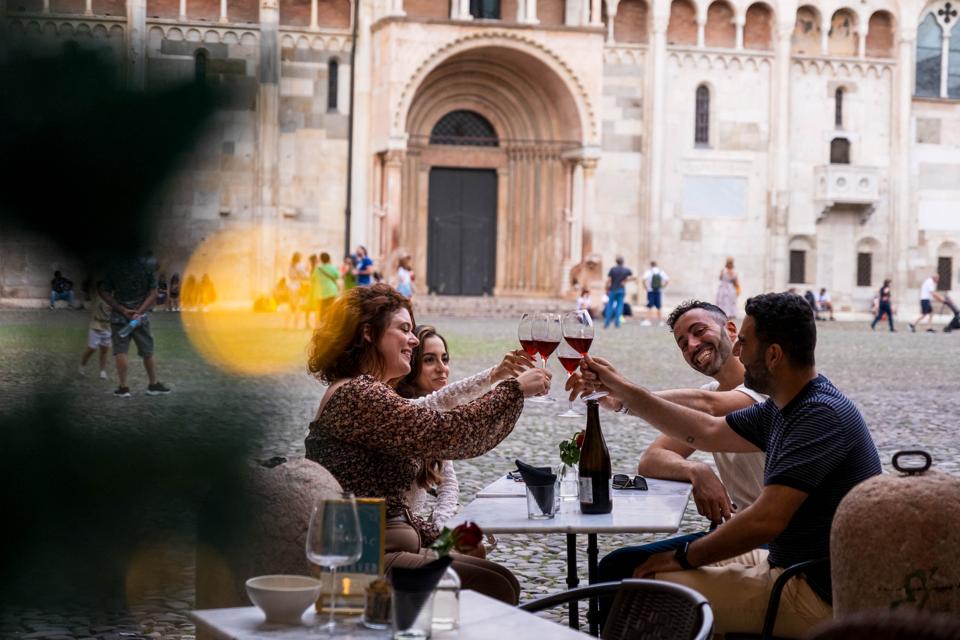This rather small, charming Emilian town is home to balsamic vinegar production, which I wish the region were more invested in promoting. The different age statements of these vinegars have a fascinating production process and they play a strong role in the food and wine offerings here.
One thing you need to note coming to this region, which is legally part of the larger region of Emilia-Romagna, is that two areas have nothing culinary to with each other. Nor are their wines at all similar in style. Honestly, at best, the two adjoined areas barely want to be part of a unified region, as many locals noted. The reunification of Italy clearly didn’t work for everyone.
Where the frontier ends geographically between the two regions is a bit fuzzy on the road, but there is no mistaking when Lambrusco disappears and Sangiovese emerges. Also, the lovely fried dough pillows call gnocchi—not to be confused with the pasta—will also turn into wrap-like piadina sandwiches once you head over to Romagna closer to the Adriatic.
Emilian Essentials
This region has long been known as the bread basket of Italy. It’s home to Parmigiano-Reggiano and Prosciutto, which are liberally served at breakfast and every single meal. Balsamic vinegar, in various age statements, is available on almost every table.
Balsamic vinegar production is fascinating and somewhat modeled on solera-style Sherry production: in that that older versions are constantly transferred into the younger ones before they are bottles. The final product can cost $100 or more for a small bottle and add a profound amount of flavor to any dish.
A trip to an acetaia–or balsamic vinegar production site–is essential here, many of them offer free tours—such as Paltrinieri—and are located not far from the city center. Some, like this one, even have their own restaurants. Vinegar and wine can’t be produced in the same places so you will have to make appointments at wineries and vinegar producers separately. Italian producers still aren’t quite ready for walk-in customers, since so many businesses are still family owned, so it is best to call ahead.
Downtown Modena
The small historical center of this, slightly less than 200,000-person, town is charming and walkable. It is also home to number of fun festivals, such as one for philosophy which was in full bloom in September. The town doesn’t seem to be set for high-end tourism yet, as there are few luxury hotels with the exception of Bottura’s Casa Maria Luigia outside of town.
The charming Albinelli Market is a great place to buy fruits and vegetables and is also home to a number of charming restaurants. Casual tables overflow with all kinds of local cold cuts and salami waiting to be stuffed into hot-out-of-the-oven gnocchi, which are puffy flat breads.
Most of the restaurants also have a nice selection of affordable wine by the glass and the bottle. While some still wines are available, Lambrusco: the area’s sparkling wine, rules the roost. You will see selections of all its iterations: from dark-purple Grassaparosa to the intense pink bubbles from Sorbara.
The Wines
Tourism is increasing here which is good to see. Americans, and Italians, are scooting around the wineries here. I met one set of girlfriends who had four appointments one afternoon, which might be perhaps testament to the fact that these wineries are much less expensive to visit than many in Napa or Sonoma.
Paltrinieri–no relation strangely to the balsamic vinegar maker of the same name–is a small family winery where I particularly enjoyed the 2023 La Riserva of Sorbara, it’s a great food wine. The TerraQuilia winery makes a wide range of diverse styles, including the Sanrosé Zero, a rosé which is fruit-juicy and easy drinking with everything from salads to meat crudo.
Cleto-Charli—strange name, nice place—is a must stop for its very appealing wines such as the Quinto Passo Rosé Brut 2017. The Lambrusco-production area is split in three parts with each producing stylistically different wines from different grapes.
Most of the wine from this region that we see in the states is the dark-hued Grasparossa variety, but many lovely pale to intense-pink wines are on offer here made from the region of Sorbarra. According to producers, many of these wines are apparently available in the U.S. market for around $20 a bottle: if we could only find them.
While I thoroughly enjoyed my adventures in this off-the-beaten-track region it is not the easiest to navigate: especially if you don’t speak Italian. A beautiful city with very few tourists awaits in Modena, but many of its denizens don’t seem to be very interested in tourism.
As a local producer told me—during my visit—the area’s residents are wealthy, busy and don’t need the tourism dollars. So, traveling in this region remains an adventure in more ways than one.
—

